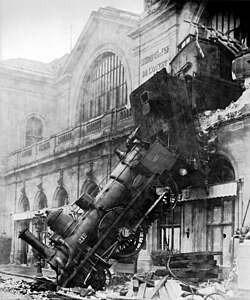Railway accident



A train accident or train wreck is a type of disaster involving one or more trains. Train wrecks often occur as a result of miscommunication, as when a moving train meets another train on the same track, when the wheels of train come off the track or when a boiler explosion occurs. Train accidents have often been widely covered in popular media and in folklore. A head-on collision between two trains is colloquially called a "cornfield meet" in the United States.[1]
Classification of railway accidents, both in terms of cause and effect, is a valuable aid in studying rail (and other) accidents to help to prevent similar ones occurring in the future. Systematic investigation for over 150 years has led to the railways' excellent safety record (compared, for example, with road transport). Ludwig von Stockert (1913) proposed a classification of accidents by their effects (consequences); e.g. head-on-collisions, rear-end collisions, derailments. Schneider and Mase (1968) proposed an additional classification by causes; e.g. driver's errors, signalmen's errors, mechanical faults. Similar categorisations had been made by implication in previous books e.g. Rolt (1956), but Stockert's and Schneider/Mase's are more systematic and complete. With minor changes, they represent best knowledge.
Classification of rail accidents by effects
[edit]- Collisions
- Collisions with trains:
- Collisions with buffer stops (overrunning end of track)
- Collisions with obstructions on the track (may also cause derailment)
- Derailments
- By location:
- Plain track
- Curves
- Junctions
- By location:
Other
- Fires, explosions and release of hazardous chemicals (including sabotage/terrorism)
- People falling from trains, collisions with people on tracks
- Attack, shooting or bombing on a train.
Classification of rail accidents by causes
[edit]- Passing signals at danger
- Excessive speed
- Mishandling of the engine (e.g. boiler explosions)
- Failure to check brakes and safety systems as well as sand reserve
- Failure to stop at required positions, e.g. level crossings with defective equipment or shunting movements that lead to occupied tracks.
Signalmen's errors
[edit]- Allowing two trains into same occupied block section
- Incorrect operation of signals, points or token equipment
(Mechanical) failure of rolling stock
[edit]- Poor design
- Poor maintenance
- Undetected damage
- Overloading or freight that is not adequately secured.
- Fire starting from combustion motors, electric cables or equipment, leaking fuel or cooling oil
Civil engineering failure
[edit]Acts of other people
[edit]- Other railway personnel (shunters, porters, maintenance personnel, etc.)
- Non-railway personnel
- Accidental
- Accidental track obstruction e.g. with road vehicles or by working construction vehicles
- Deliberate (vandalism, terrorism, suicide, extortion, sabotage).[2] People can break, place something, intentionally set the switch to a collision course, destroy tracks, and this is called rail sabotage.[3]
- Deliberate track obstruction, e.g. with road vehicles or (heavy) objects
- Intentional damage to infrastructure like tracks, points or signals
- Level crossing misuse
- Trespassing
- Attack
- Riot
Natural causes
[edit]- Track obstruction or damage by landslides, avalanches, floods, trees
- Fog or snow that obscure signals or the current position of the train
- Wet leaves (or their remains) making the tracks slippery.
Contributory factors
[edit]- Strength of rolling stock
- Fire hazards or dangerous goods in the train, in involved road vehicles or the vicinity
- Effectiveness of brakes
- Inadequate rules
Train wreck gallery
[edit]-
Train wreck in Rainy River District, Ontario, in the 1900s.
See also
[edit]- Lists of rail accidents
- The crash at Crush, Texas, an intentional train wreck conducted as a publicity stunt
- Railway accident deaths
References
[edit]- ^ "Definition of CORNFIELD MEET". www.merriam-webster.com. Retrieved 2021-07-19.
- ^ "Train Wrecks and Track Attacks: An Analysis of Attempts by Terrorists and Other Extremists to Derail Trains or Disrupt Rail Transportation". 20 July 2018.
- ^ "Are the railroads being sabotaged causing derailments?". 19 February 2023.
Bibliography
[edit]- Ludwig von Stockert (1913), Eisenbahnunfalle (Railway Accidents – a contribution to railway operating technology). Leipzig 1913.
- Schneider, Wolfgang; Armand Mase (1968). Katastrophen auf Schienen. In German, English translation 1979 by E.L. Dellow as Railway Accidents of Great Britain and Europe. Orell Fussli Verlag (German), David and Charles (English). SBN 7153 4791 8.
- Rolt, L.T.C. (1956). Red for Danger. Bodley Head / David and Charles / Pan Books. Later editions available.
Further reading
[edit]- Aldrich, Mark. Death Rode the Rails: American Railroad Accidents and Safety, 1828–1965 (2006) excerpt
- Earnshaw, Alan (January 2008). "Trains in trouble - the early years". Hornby Magazine. No. 7. Hersham: Ian Allan Publishing. pp. 114–117. ISSN 1753-2469. OCLC 226087101.
- Vaughan, Adrian. Obstruction Danger: Significant British Railway Accidents, 1890–1986 (Motorbooks International, 1989). online
External links
[edit]- BBC News: World's worst rail disasters
- A signalman (1874). . London: Longmans, Green, & Co.

